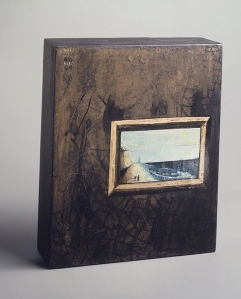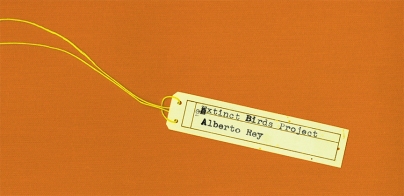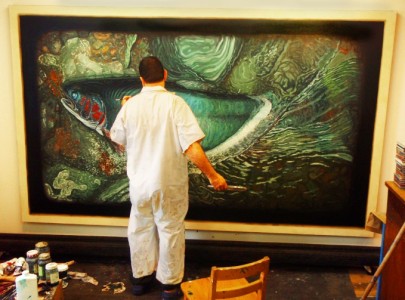Born in Havana, Cuba in 1960, Alberto Rey received his political asylum through Mexico in 1963 and moved to Miami, Florida in 1965. In 1967, his family relocated to Barnesboro, Pennsylvania (2019 inducted into the Northern Cambria Community Hall of Fame). He lived in this small coal-mining town until 1982 when he finished his B.F.A from Indiana University of Pennsylvania (2008 recipient of IUP’s Distinguished Alumni Award) after attending the Art Institute of Pittsburgh. After graduation, he lived in Boston, Massachusetts for a short period before heading to Miami to work on Christo’s Surrounded Islands Project. He then moved to Hollywood, Florida where he worked at Joan of Arts Studio. He returned north to begin his graduate studies at the University at Buffalo, New York. In 1987, he received his M.F.A. in Drawing and Painting and began traveling throughout Spain, Italy, Morocco and Mexico. The following year while teaching in Lincoln-Sudbury High School, The Art Institute of Boston, New England School of Art and Design, and the Museum of Fine Arts, he enrolled in courses at Harvard University in contemporary art and environmental studies. That same year, he had his first solo exhibition in New York City at the Museum of Contemporary Hispanic Art (MoCHA) and was also selected into the permanent collection of El Museo del Barrio in New York City.
In 1989, he moved to Dunkirk, New York to accept a teaching position at the State University of New York at Fredonia and married Janeil Strong of Gloucester, Massachusetts. In 1992, his works were selected into the permanent collections of the Albright-Knox Museum, Brooklyn Museum of Art and Bronx Museum of Art. In 1994, Alberto received the Hagan Young Scholar/Artist Award for distinguished research/creative activity as a junior faculty and the Minority Visiting Scholar’s Award from Central Missouri State University.
In 1996, while at SUNY Fredonia, Rey accepted a position as the Director/Curator at the Chautauqua Center of the Visual Arts at Chautauqua Institution. Soon afterwards he was appointed to the New York State Council on the Arts and to the Artist’s Advisory Panel of the New York Foundation for the Arts. In 1998, Alberto returned to Cuba for the first time in 36 years. In 2001, Rey received the Kasling Lecturer Award for distinguished research/creative activity as a senior faculty member and in 2003 was awarded the Chancellor’s Award for Excellence in Scholarship and Creative Activity. In 2007, the State University of New York’s Board of Trustees promoted Professor Alberto Rey to SUNY Distinguished Professor for Research and Creative Activity, the state university’s highest rank.
His artwork since 1986 has been influenced by his Cuban lineage and his attempt to find a sense of identity in a complex contemporary environment. His abstract work from 1982 through 1992 dealt with issues related to layered memories of Cuban iconography and his American experiences. After 1992, his drawings and paintings incorporated realistic imagery as an attempt to make clear connections between his past concerns and art history, regionalism, and his bi-cultural concerns.
Since his relocation to western New York in 1989, he also performed extensive research on local entomology and on the migratory and biological sensibilities of the regional steelhead. In 2000, his reflections on contemporary society started to incorporate environmental issues, perspectives in contemporary art theory and art history, biology and society’s disconnections with nature. At that point, he also began to work in film and video. His research took him throughout the United States, Wales, England, Isle de Saintes (Antiqua), Aruba, Mexico, Spain, Cuba, Iceland and Italy.
In 2014, the first book outlining Rey’s work, Life Streams – Alberto Rey’s Cuban and American Art, was published by SUNY Press in conjunction with his solo museum exhibition at the Burchfield-Penney Art Center in Buffalo. The exhibition concentrated on his Biological Regionalism Series that investigated the long history of the Scajaquada Creek and when its condition became so polluted that it was buried under the city of Buffalo, NY. The project also looks at its present condition and the challenges that the river and communtiy faces. For a few excerpts from this publication, click here.
In 2016, Alberto wrote and illustrated his first book about the holiest and most polluted river in Nepal, Complexities of Water: Biological Regionalism: Bagmati River, Kathmandu Valley, Nepal. The Nepal project also included a website, documentary and exhibition. The work investigated the cultural importance of the river, the causes of it pollution, the challenges the river and nearby community, and the future outlook for the river
In 2018, Alberto wrote and illustrated his second book, Extinct Birds Project. The project also included an exhibition and website. The project investigates the cause for the extinction of seventeen bird species, the lives of the collector’s, methods used for collecting these species and the politics and economics of classifying species as endangered or extinct. Here’s a video of the exhibition at the Roger Tory Peterson Institute.
That year, the Association of Great Lake Outdoor Writers awarded him first place for his writing and artwork in the Best of Magazine in Fishing Category for an article in Anglers Journal Magazine , “Shouts of Delight: A Father and Son Net Fish and More on a Captivating Atlantic Salmon River in Iceland.”
In 2021, Alberto wrote and illustrated the Lost Beauty: Icebergs book which investigates the history of how the project came together, the process of creating the painting, the book designer’s thought process in the layout of the publication and the dramatic effects of climate change on the Breiđamerkurjökull glacier and the rest of the world. These 200 limited edition, full color, hardcover books of numbered, signed, each has a unique drawing and can be personalized.
That same year, another book was published about Alberto’s work, Lost Beauty II – The Art of Museum Stories. For the first time ever, The Buffalo Museum of Science worked with an artist to create a site-specific exhibition centered on the museum’s extension collection of over 750,000 items. Alberto selected fifteen very small but important objects that are culturally or scientifically important. While museums can house artifacts and specimens from across time and place, it is how these items inspire others that truly gives them value. The same object or specimen invokes something different in each of us. The exhibition and publication tries to answer the following: Why are these items in the collection, and what can they tell us? Why should they matter? How does safeguarding these particular items further our understanding of the world around us?items from their archives and, through his paintings, look beyond the scale, label, or fragment, to appreciate the lost beauty within.
 Also in 2021, “Canadaway Creek – Western New York” was published. Alberto secured funding, organized and contributed to the publication which started in 2018 when a group of faculty from the State University of New York at Fredonia applied for a grant to fund the publication. It explores the flora, fauna, geology and history of a small but important stream that flows through several communities in western New York. The team of passionate volunteers was comprised of diverse university faculty and students who worked together with community members to create an educational and holistic document that would provide an important record of the complexities of Canadaway Creek for future generations.
Also in 2021, “Canadaway Creek – Western New York” was published. Alberto secured funding, organized and contributed to the publication which started in 2018 when a group of faculty from the State University of New York at Fredonia applied for a grant to fund the publication. It explores the flora, fauna, geology and history of a small but important stream that flows through several communities in western New York. The team of passionate volunteers was comprised of diverse university faculty and students who worked together with community members to create an educational and holistic document that would provide an important record of the complexities of Canadaway Creek for future generations.

In 2022, “Biological Regionalism: Oswego River and Lake Ontario, Central New York, USA” was published. The publication accompanied the exhibition at the Tyler Art Gallery at the State University of New York at Oswego. The book, written in large part by the faculty on campus, examines the artwork created for the exhibition, the history and the challenges that the Oswego River continues to face, paintings of a small selection of threatened plant species found in New York State and the role of the Rice Creek Field Station on the campus and in the region. The exhibition includes drawings, photographs, paintings, videos and a mural map of the river.
Also in 2022, Alberto collaborated with the Native American Fish and Wildlife Society, United States Forest Service, Orvis, and Jason Dilworth to created a publication to document the week-long Summer Youth Practicum where a dozen high school students from nine national tribes came to Colorado to participate in leaderships programs, outdoor enrichment, cultural awareness and professional development. I also provided drawing workshops, stream biology sessions and fly fishing lessons.
collaborated with the Native American Fish and Wildlife Society, United States Forest Service, Orvis, and Jason Dilworth to created a publication to document the week-long Summer Youth Practicum where a dozen high school students from nine national tribes came to Colorado to participate in leaderships programs, outdoor enrichment, cultural awareness and professional development. I also provided drawing workshops, stream biology sessions and fly fishing lessons.
A full listing of the these publications are available at Canadaway Press.
Alberto’s paintings can be found in over twenty museum collections and have been in around 200 exhibitions. His films/videos have been screened internationally and his illustrated articles and artwork have graced the covers and pages of Gray’s Sporting Journal, Art of Angling Journal, Fish and Fly Magazine, American Angler, The Drake, Saltwater Fisherman, Angler’s Journal, Fly Fishing International Magazine, Hallowed Waters Journal, and Buffalo Spree where he is their visual arts writer. A list of essays, reviews and other details about his accomplishments can be found under vitae.
He has also combined this recent research with his interest in sharing the spirituality of fly fishing to become an Orvis Endorsed Fly Fishing Guide. He was the international finalist for the 2020 Orvis’s Freshwater Guide of the Year Award and the international winner of the 2021 Orvis Guide of the Year. He is also the founder and director of the Children in the Stream/ 4H Youth Fly Fishing Program for the past twenty years.
Alberto Rey and his family now live in Fredonia where he works in his studio/barn, guides on the steelhead stream behind his home and has recently retired from the Department of Visual Arts and New Media at the State University of New York at Fredonia where he was a Distinguished Professor.
To view Alberto’s lecture on his work in conjunction with Alberto Rey’s retrospective exhibition, Life Streams, at the Ogunquit Museum of American Art in Ogunquit, Maine, you can click here or you can watch another recent lecture from February 2023 for the University of Buffalo. He discussed the evolution of his work over the past thirty years and the community work that influenced his artwork. Articles about his work has been written in 2018, 2019, 2020, 2021 and 2023. The Virginia Sportsman magazine also published an extensive article about Alberto’s work and life in their Fall 2023 issue.
If you would like more information on Alberto Rey, you can also go to the Burchfield Penney Art Center’s “Living Legacy Project” .Feel free to contact him at home at 716.410.7003 or send him an email here or follow him on Instagram or Facebook. Available work can be seen here.












You must be logged in to post a comment.